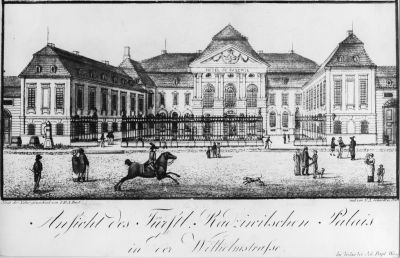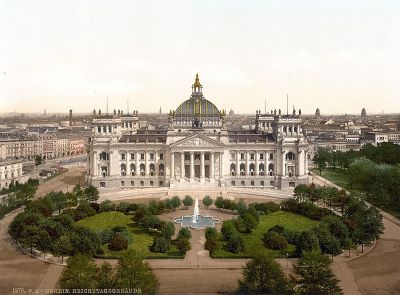Palais Radziwill

On Thursday 17th March 1796 very few of the invited wedding guests could have guessed that the great love between a young bridal couple would not only bring two people closer together, but also two nations. Furthermore their joint house in Berlin was not only to become an international meeting point for major personalities from the worlds of art and society, but also the office of an Imperial German Chancellor.
It was the wedding of Anton Radziwiłł and Luise Friederike of Prussia. Tough bargaining was necessary in order to permit the wedding. The bridegroom was in no way socially equal to the bride. Luise was a Prussian princess and the daughter of the youngest brother of Friedrich the Great. Anton, by contrast, came from a respected and influential Polish aristocratic family, but he was a Pole and in addition still a Catholic. That the wedding took place nonetheless is on the one hand thanks to the stubborn and energetic princess; on the other hand it could also be put down to Prussian political calculations. For the Prussian king the wedding signified an indirect recognition of the Prussian annexation of parts of Poland. For Luise of Prussia it was the fulfilment of her love.
After the wedding the young Polish-Prussian family remained in Berlin. Only a year previously Anton Radziwiłł had ensured that they would move into a residence worthy of their status, a palace in the centre of Berlin at Wilhelmstraße 77, that from now on was to be known as the “Palais Radziwiłł“. The marriage was indeed harmonious and happy. Anton and Luise had four children. Both daughters were brought up in the evangelical faith; both sons were baptised and brought up as Roman Catholics. The harmonious atmosphere in the Palace offered many opportunities for social life. For almost twenty years the Palais Radziwiłł played hosts to regular visits from well-known personalities, artists and academics. These included such famous people as Johann Wolfgang von Goethe, Frederic Chopin, Wilhelm and Alexander von Humboldt, Felix Mendelssohn-Bartholdy and Karl Friedrich Schinkel. Indeed the “Salons” held by the Radziwiłłs was so popular that they became a symbol of “Polish Berlin”. Later too the Palais Radziwiłł was a meeting point for Polish politicians in the Prussian Parliament where they could exchange ideas and opinions on how to solve the long-standing question of what to do about Poland.
The Radziwiłł family lived in their palace for a further three generations until it became too small. In 1875 the residence was sold to the German Reich. From now on Wilhelmstrasse 77 would be the new home of the Reich Chancellor. It was not long before Otto von Bismarck moved into the freshly renovated rooms. The Chancellor of the German Reich was not exactly an open friend of Poland. Even today it is not completely clear whether he was aware of the heavy symbolism of the address from which he now ruled, or whether he chose this address deliberately. Whatever the case the Palais Radziwill and the Radziwill family played a major role in promoting Prussian-Polish relationships in Berlin.
In 1933 the National Socialists moved into the Palace. The final destiny of the building was sealed by its last tenant, Adolf Hitler, who used the Palace as a private residence after the new Reich Chancellery was completed in Voßstrasse. When the Red Army marched into Berlin in 1945 the palace was so heavily damaged that it had to be demolished in 1949.
Adam Gusowski, September 2014



